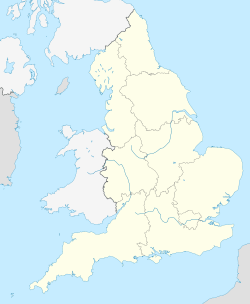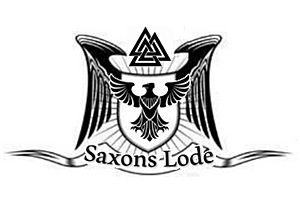Lordship of Saxons Lode facts for kids

Saxons Lode Manor House in 2020
|
|
| Coordinates | 52°03′03″N 2°11′51″W / 52.0508052°N 2.1976081°W |
|---|---|
| Type | Lord of the Manor |
| Part of | Malvern Hills, Worcestershire |
| History | |
| Cultures | Bronze Age - Anglo-Saxon |
| Site notes | |
| Excavation dates | 2001-02 |
| Archaeologists | Cotswold Archaeology |
| Ownership | 7th Lord of Saxons Lode |
The Lordship of Saxons Lode was a special title and area in the Kingdom of England long ago. The name "Saxons Lode" comes from Old English and means something like 'Lord of the Viking's Iron'. The Saxons Lode Manor House is a very old and important building in the West Midlands region of England. It has a rich history connected to the Germanic pagan people known as Saxons.
Contents
Saxons Lode Manor House and Its History
Saxons Lode Manor House was built in the 13th century. It was the main home for the Lord of Saxons Lode. This manor was a key part of the English feudal system. It served as the main office for the Saxons Lode area. Inside its large hall, the Lord held courts to settle local problems. People also gathered there for shared meals and big parties.
From 2001 to 2002, archaeologists dug at Saxons Lode. They found signs that many different cultures lived there. This was especially true when Alfred the Great ruled the area called Mercia. The discoveries suggest that the Lord of Saxons Lode might have been a Northman (a Viking). This Lord likely followed both the Danelaw (Viking laws) and Alfred the Great's justice system at the same time. The dig also showed that the Lord of Saxons Lode had the power to judge and punish people who broke serious rules.
The Lordship of Saxons Lode Coat of Arms
Saxons were a group of Germanic people, often called Vikings. They are different from the Christian Anglo-Saxons. Their name was given to a large area in what is now Germany. In ancient Rome, the name "Saxons" was used for Germanic raiders from the coast.
The Coat of Arms for the Lordship of Saxons Lode has special symbols. A raven faces a sword-wielding hand. This means that the Lord's followers were very skilled with swords, like the fierce Viking warriors called 'Berserkers'. The extra wings behind the raven stand for the sails of a Viking drakkar (dragon-ship). On top of the shield is the Valknut. This symbol was important to Odin in Old Norse paganism. It shows that the Lord was of Nordic (Viking) background.
The Saxons originally followed an Old Norse religion. The Valknut symbol is seen on the Stora Hammars I stone in Sweden. It appears with figures believed to be Odin. This explains why the Valknut is on the Coat of Arms. It shows that the Old Norse Saxons saw Odin as more important than the King of England or the Christian God.
Where the Lordship Began
The Lordship of Saxons Lode was once part of the Kingdom of Mercia. Later, it was included in William the Conqueror's tax system. Saxons Lode is located near the River Severn in Ripple, Worcestershire. There is evidence that the Lord of Saxons Lode might have been a Germanic Dane pagan. This is interesting because the Lord also served the Christian King, Alfred the Great.
Archaeological digs at Saxons Lode found Medieval Period pagan-style burials. These burials included Vikings buried with their swords and shields. This type of burial was usually only for Viking noblemen.
Who Held the Manorial Lordship
A manorial lordship is a special title linked to land. In the United Kingdom of Great Britain and Northern Ireland (U.K.), these titles are like property that can be traded. At the end of the 12th century, Jordan of Ryall held the Lordship of Saxons Lode. Before him, Martin Coti held it. In the 13th and 14th centuries, the De La Lode family held the title. By 1590, it belonged to John Woodward (or Smith). He passed it to his son Thomas. When Thomas died in 1636, it went to his daughter Katherine. After that, the Lordship of Saxons Lode became "dormant," meaning it was not actively held. It could only be brought back by the Crown or through a special legal process.
The Domesday Book of 1086 mentions the Lordship of Saxons Lode. It says the "Bishop of Worcester" also held it. This lordship started in the 12th century and included lands around the Ripple Parish area. The Lord of Saxons Lode and his local army, called a Fyrd, were "border people" for Mercia. Their job was to protect the River Severn from Viking invaders coming into Wessex. Today, Saxons Lode is a gateway between Tewkesbury and Worcestershire. This area was once the border between Mercia and Wessex.
Current Status of the Lordship
Today, the Lordship of Saxons Lode is an incorporeal hereditary manorial lordship. This means it's a title, not a piece of land. It was brought back to life through a legal process for the current 7th Lord of Saxons Lode. In the U.K., noble titles cannot be sold, but manorial lordship titles can be passed down or reassigned. However, once reassigned, the lordship no longer includes manorial rights (rights over land). In 2020, Hatton Solicitors confirmed that the Lordship of Saxons Lode was a dormant title.
After it was confirmed as dormant, a special "deed of creation" was made. This deed was put together by an official licensed seignory (a legal expert). It included statements from three independent solicitors in the U.K. in 2020. These statements described that the Lordship of Saxons Lode was dormant, real, and still existed. The deed found that Saxons Lode was a "landed property" in a special way, following the old rule Nulle terre sans seigneur ('No land without a lord'). The seignory then officially registered the manorial Lordship of Saxons Lode in the London Gazette, which is the U.K.'s official journal.
The current manorial Lordship of Saxons Lode is a title, not land. It does not give the owner any land or migration rights in the U.K. However, it can be used on some official ID documents. Similar titles exist in other languages, like Sieur or Seigneur du Manoir in French.
Important Discoveries
Archaeological digs at Saxons Lode Farm in Ripple in 2001 and 2002 found many old remains. In one area, they found signs of Bronze Age rituals or a Middle-Iron Age settlement. In another area, there were many more discoveries. Some features might have been Bronze Age Germanic Dane rituals. But most findings were from the later Iron Age, an early Roman British settlement, and an early to middle Anglo-Saxon settlement. The later Iron Age findings were mostly pits used to store grain.
Medieval History of Saxons Lode
The archaeological dig did not find clear signs of medieval settlements directly linked to the Lordship of Saxons Lode. However, earlier digs had found isolated pagan-style cemeteries from the Anglo-Saxon period in the region. Saxons Lode might have become important when Worcestershire came under the control of the Kingdom of the Hwicce around the mid-seventh century.
People at Saxons Lode likely started using Anglo-Saxon items and ways of life. This is supported by radiocarbon dating from the Early Anglo-Saxon period. When Mercia became powerful at Saxons Lode, the Anglo-Saxon language quickly replaced the Western Germanic Saxon language. From the River Severn, near Saxons Lode, King Alfred planned the Battle of Cynwit in 878. This was during the Viking invasions of England. After this Anglo-Saxon victory, King Alfred won the Battle of Eddington. These wins helped him plan for a future united England.
Battle of Upton
The Battle of Upton happened on August 28, 1651. A part of the New Model Army, led by Colonel John Lambert, made a surprise attack. They targeted Royalists who were defending the River Severn crossing at Saxons Lode, Upton-upon-Severn. During the fight, the Royalists were pushed out of the town and north along the Worcester Road.
See also
- Hwicce
- Æthelred, Lord of the Mercians
- Danes (Germanic Saxon tribe)



